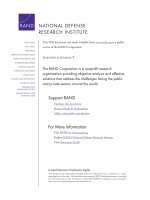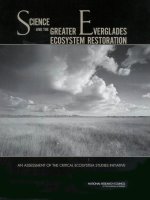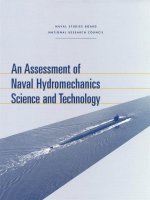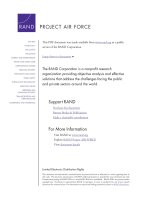An assessment of “Knowledge” of beneficiaries and non-beneficiaries regarding diversified agriculture support project (DASP) in District allahabad (Uttar Pradesh), India
Bạn đang xem bản rút gọn của tài liệu. Xem và tải ngay bản đầy đủ của tài liệu tại đây (298.38 KB, 6 trang )
Int.J.Curr.Microbiol.App.Sci (2020) 9(3): 3130-3135
International Journal of Current Microbiology and Applied Sciences
ISSN: 2319-7706 Volume 9 Number 3 (2020)
Journal homepage:
Original Research Article
/>
An Assessment of “Knowledge” of Beneficiaries and Non-Beneficiaries
regarding Diversified Agriculture Support Project (DASP) in District
Allahabad (Uttar Pradesh), India
H. A. Malik1*, Nusrat Jan2 and Sabiha Ashraf3
1
2
Directorate of Extension, SKUAST-Kashmir, India
A. E. A, Department of Agriculture, GoJK, Bandipora, Kashmir, India
3
College of Temperate Sericulture, SKUAST-Kashmir, India
*Corresponding author
ABSTRACT
Keywords
Knowledge, Impact,
Technological
interventions,
World Bank, farm
yield
Article Info
Accepted:
28 February 2020
Available Online:
10 March 2020
A study was conducted in District Allahabad, Uttar Pradesh State of India to assess the
knowledge of beneficiaries and non-beneficiaries towards different scientific interventions
and their potential prospects being offered under World Bank supported flagship
programme viz Diversified Agriculture Support Project (DASP). For this purpose, a series
of relevant questions / statements with respect of Agriculture (Crop Husbandry),
Horticulture, Animal Husbandry, Fisheries and Sericulture were administered on
beneficiaries and non-beneficiaries. The major findings of the study revealed that majority
of beneficiaries (50.66 per cent) had high level of knowledge and percentage of
beneficiaries with medium of knowledge was estimated at 40.00 while 9.33 per cent of the
beneficiaries had low level of knowledge. In comparison, majority of Non-beneficiaries
(88.66 per cent) had low level of knowledge followed by 9.33 per cent with medium level
of knowledge and only 2.00 per cent of non-beneficiaries had high level of knowledge.
The data reflected that beneficiaries had comparatively high level of knowledge than nonbeneficiaries regarding agriculture technologies being provided to them through DASP.
The knowledge gained through scientific interventions, trainings, demonstrations and other
important extension activities was highly instrumental for increasing the farm yields and
net returns of beneficiaries under DASP than Non-beneficiaries who were seen lagging
behind on almost all attributes & parameters designed for the purpose.
Introduction
A broader initiative in the form of Diversified
Agriculture Support Project (DASP) was
introduced by the Government of India for
technology development and dissemination
with respect to agriculture and allied sectors in
two States - Uttar Pradesh and Uttaranchal
with financial support from the World Bank
with the objective to accelerate the growth of
UP‟s diversified agriculture in relation to
agro-ecological potential and well designed
market demand system. At the time of
initiation of this project, contribution of Uttar
3130
Int.J.Curr.Microbiol.App.Sci (2020) 9(3): 3130-3135
Pradesh was 41.8 million tons in the national
food grain production of 194.1 million tons.
By the end of year 2015-16, the contribution
of Uttar Pradesh was targeted at 44.01 million
tons in the national food grain production of
252.22 million tonnes (Anonymous-2016)1.
Social capital has positive impacts on
agricultural production and income of the
people (Yokoyama,-S; Sakurai,-T, (2003)5.
Therefore, cluster approach and development
of small organization was one of the major
focuses under DASP.
Since these organizations undertake a great
variety of strategies to increase their incomes
through improved farm management and
diversified income sources (Guyau,-L 2004)2.
Therefore, the financial support and quantum
of assistance provided under DASP,
technological backstopping, critical inputs
supplied, training and demonstrations
conducted under the programme offered a
tremendous scope to assess and evaluate the
knowledge gained and skill developed on
practical aspects of the given potential
technologies and the benefits of such
interventions thereof in terms of increased
quality production, productivity, efficient
marketing facilities, better returns by the
beneficiaries compared to Non-beneficiaries
who were believed to still follow traditional
system of agriculture. Under the above
backdrop, the present study was carried out
with five objectives wherein one of the
important objectives was, “To assess the level
of knowledge of beneficiaries and nonbeneficiaries
towards
agricultural
intervention/innovation”
Materials and Methods
Uttar Pradesh consists of 32 districts and the
project activities were implemented by the
Government in the selected blocks of all
districts in the State which had the potential to
serve as growth centers and where
infrastructure and institutions are developed
and scope for private sector investments was
high. The farming communities were
mobilized for problem /issue identification,
joint problem solving and efficient technology
dissemination. Allahabad district was selected
purposively for the study. It is pertinent to
mention here that in selected district, 5 blocks
were brought under DASP programme by the
Government and two villages from each block
were randomly selected for the study.
The respondents were sixty in each block
covering five blocks with 10 villages; total
size of sample consists of 300 respondents‟
with150 beneficiaries and 150 nonbeneficiaries. Stratified random sampling
procedure was adopted for the study. Keeping
in view the purpose and objectives of the
study, information and opinions were obtained
firstly on pilot basis followed through personal
interview with the help of well-designed prestructured schedule. The data collected from
beneficiaries and non-beneficiaries were then
tabulate, analyzed in light of pre- determined
objectives for the present study.
Further, in order to determine the level of
knowledge of beneficiaries and nonbeneficiaries with respect to Agriculture (Crop
Husbandry), Horticulture, Animal Husbandry,
Sericulture and Fisheries a series of relevant
questions/ statements were administered on
beneficiaries and non-beneficiaries. Each item
and response were given a particular score, the
score level were first categorized into „No
knowledge‟ (NK), „Partial knowledge‟ (PK)
and „Full knowledge‟ (FK). A score of zero
was given for „No knowledge‟, 1 for „Partial
knowledge‟ and 2 for „Full knowledge‟. Thus
the total score for each item and each
respondent were summarized and tabulated.
Suitable Statistical measures were adopted to
determine the comparative analysis in respect
of knowledge of beneficiaries and nonbeneficiaries.
3131
Int.J.Curr.Microbiol.App.Sci (2020) 9(3): 3130-3135
Results and Discussion
Knowledge level of respondents
In order to determine the level of knowledge
of beneficiaries and non-beneficiaries with
respect to Agriculture (Crop Husbandry),
Horticulture, Animal Husbandry, Sericulture
and Fisheries a series of most relevant and
important questions were framed. The number
of questions administered for the purpose with
respect to Agriculture (Crop Husbandry) were
21, for Horticulture the number of questions
were 7, 5 questions were designed for Animal
Husbandry, 4 for Fisheries and 3 questions
were formulated for Sericulture, thus a total
number of forty (40) questions were enlisted
regarding the level of knowledge of
beneficiaries and non-beneficiaries towards
scientific interventions regarding Agriculture
& Allied activities. The statements thus
designed for the purpose is highlighted under
Table-1
Each item (statement) and response were
given a particular score, the score levels were
first categorized into „No knowledge‟ (NK),
„Partial knowledge‟ (PK) and „Full
knowledge‟ (FK). A score of 0 (zero) was
given for „No knowledge‟, 1 (one) for „Partial
knowledge‟ and 2 (two) for „Full knowledge‟.
Thus the total score for each item and each
respondent were summarized and tabulated.
interventions between beneficiaries and nonbeneficiaries. The beneficiaries brought under
the ambit of DASP were at par in respect of
scientific knowledge than that of nonbeneficiaries. The same is summarized under
Table-2
Comparison
respondents
of
Knowledge
of
the
In order to find out whether there was a
significant
difference
between
the
beneficiaries and non-beneficiaries with
respect to their level of knowledge regarding
various
technologies;
the
following
Hypothesis was formulated for the purpose:
Null Hypothesis (Ho): There was no
significant difference between beneficiaries
and non-beneficiaries in respect of their level
of knowledge regarding various agriculture
technologies.
Research Hypothesis (H1): There was a
significant difference between beneficiaries
and non-beneficiaries in respect of their level
of knowledge regarding various agriculture
technologies.
After due consultation with statistician and
based on the nature of data, the Chi- square
test was adopted for testing these hypothesis.
Chi -Square test (X2-test)
Analysis of the data revealed that in case of
beneficiaries the lowest score was estimated at
20 while the highest score was recorded as 40
with an average (mean) score and standard
deviation of 29.40 and 5.70 respectively.
Similarly, in case of non-beneficiaries the
lowest score was estimated at 10 while the
highest score was recorded as 30 with an
average (mean) score and standard deviation
of 14.36 and 4.10 respectively. Thus a
significant & prominent difference could be
felt in terms of knowledge of scientific
X2
O E 2
E
Where;
O is the “Observed Frequency” in each
category
E is the “Expected Frequency” in the
corresponding category
3132
Int.J.Curr.Microbiol.App.Sci (2020) 9(3): 3130-3135
Table.1 Knowledge statements regarding Agriculture & Allied sectors
S.No
1.
1.
2.
3.
4.
1.1
1.2
1.3
1.4
5.
6.
7.
8.
9.
10.
11.
12.
13.
14.
15.
16.
17.
18.
19.
20.
21.
1.5
1.6
1.7
1.8
1.9
1.10
1.11
1.12
1.13
1.14
1.15
1.16
1.17
1.18
1.19
1.20
1.21
22.
23.
24.
25.
26.
27.
28.
2.1
2.2
2.3
2.4
2.5
2.6
2.7
2.
3.
29. 3.1
30. 3.2
31. 3.3
32. 3.4
33. 3.5
4.
34.
35.
36.
37.
4.1
4.2
4.3
4.4
5.
38. 5.1
39. 5.2
40. 5.3
Statement
N.K*
Knowledge regarding Agriculture (Crop Husbandry)
What are high yielding varieties
Do you use high yielding varieties
The recommended dose of N:P:K for Wheat is 120:60:40
The recommended dose of N:P:K for Rice is 120:60:60
What is organic farming
What is Integrated Nutrient Management (INM)?
Do you use bio-fertilizers
Can you name some of the bio-fertilizers
Why Soil testing is necessary.
What necessary measures should be taken before Soil testing?
Do you have Soil Health Card.
Do you follow the recommendations as per the status of the Soil Health Card.
What is the symbol of a quality seed?
Do you carry out seed treatment?
What is Integrated Pest Management (IPM)?
Can you name some of the common diseases of your crops
What is zero-tillage
What are the advantages of zero –tillage
Why crop rotation is necessary
What is vermi-compost
How much time will it take to prepare vermin-composite.
Knowledge regarding Horticulture
What is Diversification of Agriculture
How can you make your agriculture more remunerative & demand driven
Can you please name some of the important insects/pests of vegetables?
Have you ever been trained to grow vegetable crops under "protected cultivation".
Have you brought more land under fruits/vegetables after joining DASP?
What is intercropping?
Have you ever participated in any V N T programme organized by DASP?
Knowledge regarding Animal Husbandry
What is artificial insemination
A.I has got less chance for conceiving animal.
Have you ever received any guidance/input from paravet services operating in your
village?
Can you specify some crossbreeds animals
The average milk yield of local cow (lit/day/animal) and crossbreed cow is same
Knowledge regarding Fisheries
Do you know fish farm
Are you doing fish farming on a group basis
Have you taken the land on lease?
Is good quality seed available at Govt fisheries centre?
Knowledge regarding Sericulture
Do you know about Sericulture?
Do you rear silk-worm
Do you get technical advice/input about scientific rearing of silk-worm from the
concerned Department/University / KVK?
N.K*= No knowledge (score=0)
P.K*= Partial knowledge (score=1) and
F.K*= Full knowledge (score =2)
3133
P.K*
F.K*
Int.J.Curr.Microbiol.App.Sci (2020) 9(3): 3130-3135
Table.2 Statistical measures with respect of knowledge of the respondents
(N=300)
Statistical measure
Beneficiaries
Non-Beneficiaries
Mean (average score)
29.40
14.36
Standard deviation
5.70
4.10
Range (score)
20 to 40
10 to 30
Table.3 Classification of the Knowledge score of the respondents
S.No
Knowledge level
Beneficiaries
1
2
3
Low (10-20)
Medium (20-30)
High (above30)
14 (9.33)
60 (40.00)
76 (50.67)
(N=300)
Non-beneficiaries
133 (88.67)
14 (9.33)
03 (2.00)
Calculated .X2 =192.38
Tabulated.X2 at 2 degree of freedom and 5% probability level=5.991
Note: Figures in parenthesis are the percentage (%).
The knowledge score for each statement and
response for beneficiaries and nonbeneficiaries were calculated, summarized and
tabulated. The score levels were then
classified into three categories i.e Low,
Medium and High. For low knowledge level,
the score ranges from 10 to 20, for medium it
was 20 to 30 and above 30 score was
classified into high level score. It was
observed that in case of beneficiaries 50.67
per cent of the respondents were observed to
have high level of knowledge followed by
40.00 per cent with medium level of
knowledge and 9.33 per cent of the
respondents had low level of knowledge.
However, in case of non-beneficiaries the
results were found very much different with
88.67 per cent of the respondents having low
level of knowledge followed by 9.33 per cent
with medium level of knowledge and only
2.00 per cent of respondents were found to
have high level of knowledge. The results
were in conformity with the study conducted
by Vinod-Prakash (2007)4 who found that
most important variables including education,
size of land holding (ha), occupation, farm
power, annual income and extension contact
were found highly significant and positively
correlated with extent of knowledge of the
respondents. Further, Subhash; Mehta et al.,
(2006)3 found that all the socioeconomic
characteristics except age had positive and
significant
association
with
farmers'
knowledge level about the recommended
technologies. The Knowledge score thus
obtained is highlighted under Table-3
Calculated X2 was found greater than
tabulated X2 at 2 degree of freedom and 5%
probability level, hence Null hypothesis (Ho)
was rejected and Research Hypothesis (H1)
got accepted. Therefore, it was concluded that
there was a significant difference between
beneficiaries and non-beneficiaries with
respect to their level of knowledge. The
beneficiaries had comparatively high level of
knowledge than non-beneficiaries regarding
agriculture technology being provided through
DASP.
It was concluded that besides various factors
including transfer of the demand driven /
3134
Int.J.Curr.Microbiol.App.Sci (2020) 9(3): 3130-3135
farmer-oriented / need based technologies and
their adoption coupled with effective
extension services and timely advisories that
resulted in higher production / productivity
and enhanced farm income to the beneficiaries
compared to non-beneficiaries ; one of the
very important factors instrumental in this
regard was- “Knowledge and its adoption” on
scientific interventions related to agriculture &
allied activities that were provided to the
beneficiaries through need based trainings on
thematic areas, skill orientations programmes,
demonstrations, learning by doing and other
innovative extension approaches.
References
Anonymous (2016) Agricultural Statistics at a
Glance
2016,GoI,
Ministry
of
Agriculture & Farmers Welfare,
Directorate
of
Economics
and
Statistics wing.
Guyau,-L (2004); Economic organization: an
asset for world farmers, Paris, France:
Assemblee
Permanente
des
Chambresd' Agriculture, Chambers-d'-
Agriculture. (934): 9-30
Subhash-Chander; Mehta,-S-K et. Al (2006),
Relationships of farmers' socioeconomic traits with their knowledge
level about pearl millet production
technology, Hisar, India: Agri Bio
Research Publishers., Annals-of-AgriBio-Research.; 11(1): 89-92
Vinod-Prakash, (2007), Impact of knowledge
of potato growers regarding potato
production technology, Muzaffarnagar,
India: Hind Agri-Horticultural Society,
International- Journal - of - Plant Sciences –Muzaffarnagar.;2(1):146150
Yokoyama,-S; Sakurai,-T, (2003), Potential of
social
capital
for
community
development. Report of the APO,
Tokyo, Japan: Asian Productivity
Organization (APO), Potential-ofsocial-capital-for-communitydevelopment-Report-of-the-APOsurvey-and-symposium-onredesigning-integrated-communitydevelopment 250-251.
How to cite this article:
Malik, H. A., Nusrat Jan and Sabiha Ashraf 2020. An Assessment of “Knowledge” of
Beneficiaries and Non-Beneficiaries regarding Diversified Agriculture Support Project (DASP)
in District Allahabad (Uttar Pradesh), India. Int.J.Curr.Microbiol.App.Sci. 9(03): 3130-3135.
doi: />
3135









